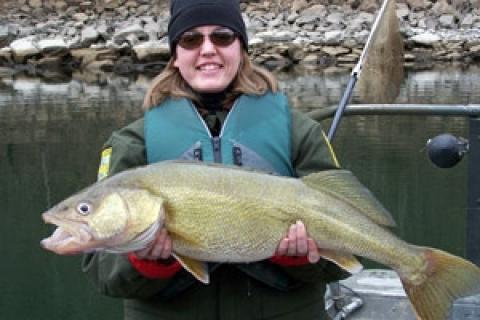
To mention walleye is to think "northern climes." Millions of tourism dollars have traditionally flowed to the northern tier of states where walleye is king. However, in the last four decades, the traditional lines of walleye fishing have slipped southward. Missouri, Arkansas, Kentucky and Tennessee have produced the four largest walleye on record, all over 21 pounds. Tennessee holds the big fish title with a whopping 25 pounder caught from Old Hickory Lake in 1960.
 Needless to say walleye of those proportions developed a following. If you, too, want to have a shot an an enormous "moon eyes," go South.
Needless to say walleye of those proportions developed a following. If you, too, want to have a shot an an enormous "moon eyes," go South.
Long time walleye fisherman and guide Mike Jones of Alton, Missouri catches big walleye on the lower Current River. "Big walleye are smart fish," Jones said. "I catch most of my bigger 'eyes at night using large minnows."
Successful stocking programs by southern conservation agencies have led to successful fisheries. Once fishermen have conquered their initial shock and tasted the delectable white flesh of walleye, trying to intentionally catch more "moon-eyes" presents the first of many challenges in the paths of these newborn walleye aficionados.
Understanding walleye biology key
To catch southern walleye consistently, you must understand their biology and habitat requirements. Walleye feed almost exclusively under low light periods, at dawn and dusk. Structure, including rocks, timber, and the edge of weed lines provide favorite hangouts. Here they feed on crayfish and leeches. Baitfish, usually found in deeper water, is also primary food source.
Walleye require highly oxygenated water and prefer moderately clear water with a moderate pH level. Temperatures from 68-to-73-degrees are perfect, but walleye can tolerate levels from 32-to-86 degrees, which has contributed markedly to their survival rates in southern reservoirs.
Walleye Tactics Vary
 |
| Walleye grow much faster in southern environments, and many walleye experts predict the next world record walleye will come from south of the Mason-Dixon Line. Photo courtesy of Kentucky Fish and Wildlife |
Talk to locals. When approaching a new lake, talk to tackle store owners. They can eliminate unproductive waters for you quickly.
Target points and tops of flats. Reservoir walleye are highly mobile. Target the ends of main lake points and the tops of large flats. Step one is to locate schools of fish, which most often hang around structure. If you do not find fish on traditional structure, check nearby locations. For example if you catch fish in 18 feet of water on one point, search for them at the same depths on other points.
Fish the weeds. Walleye love weeds. Check for fish suspended over massive weed beds, or just off the weed beds at the same depth. The water depth at the outside edge of weed beds is the key to finding nearby fish.
Be flexible. Walleye move on and off structure in response to bait fish movements, weather changes and fishing pressure. Fish the structure you find on your electronics. However, if the fish are not on traditional structure, use a locator to find suspended fish either above or off to the sides of the structure.
Zigzag your boat. Zigzagging your boat back and forth across the structure is the preferred method to find suspended fish. In deep water, walleye seek out submerged islands, humps and underwater points. Zebra mussels have invaded many waterways. Their beds have in turn become favorite walleye hangouts.
Trolling is standard. Trolling is the standard method for taking suspended walleye. Your bait stays in the strike zone longer and unproductive areas can be quickly eliminated. Spinner rigs work well for methodically fishing a school of walleye.
Match the Hatch
 |
| Crayfish colored crankbaits are good prospecting lures for walleye. |
Imitate baitfish. Walleye eat a lot of baitfish. Matching the size of available forage pays big dividends. Try these baits, available at Bass Pro Shops:
- Shad Rap
- Storm Thunder Stick
- Lucky craft Pointer Minnows
- Wiggle Warts
- Bass Pro Shops Lazer Eye Crankbaits
Adding a pinch of night crawler to the trebles on these baits often gives walleye exactly what they want.
Use correct colors. Dark, crawdad patterns work well in deep water. Chartreuse should be used in the deepest, dark water and the lighter colors and metallics work best in clear waters. Trolling a variety of crankbait colors together allows you to prospect various depths until fish are found. Then it is simply a matter of modifying your rigs with the right colors and depths.
Two facts to remember:
- Walleye cruise weed edges and sometimes suspend near structure to feed on schools of baitfish in deeper water.
- During low light periods, walleye move into shallow water where they feed heavily. Dawn, dusk, and after dark are the peak of walleye feeding periods. They utilize their name sake eyes to take advantage of forage fish that cannot see so well in low light conditions.
Go south for bigger and better walleyes. And for that real down home adventure, add some hominy grits and mint juleps!
- 15389 views

